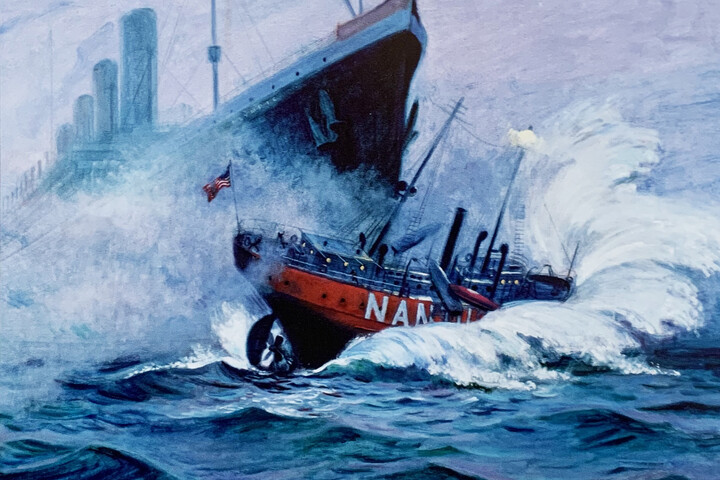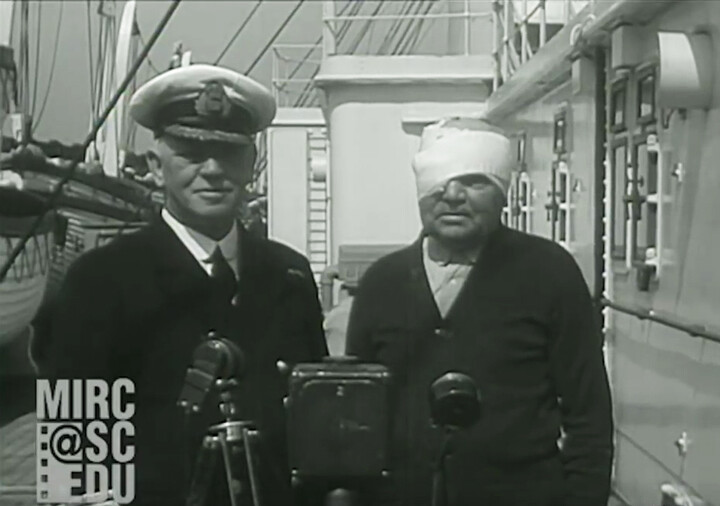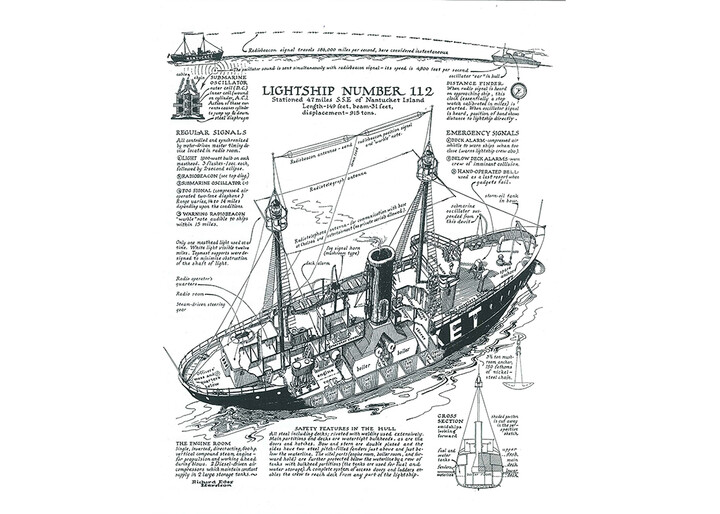
"Lightship Nantucket Sunk by R. M. S. Olympic" by Charles Mazoujian. Commissioned by the United States Coast Guard (USCG) as part of the U. S. Bicentennial in 1976. A copy of this painting is on display at the Nantucket Shipwreck & Lifesaving Museum thanks to the generosity of the USCG.
The 85th Anniversary of the Sinking of the Nantucket Lightship LV-117
By Michelle Cartwright Soverino
The Nantucket
South Shoals Lightship (LV-117) was anchored 43 miles off the island, stationed by the Nantucket Shoal near the trans-Atlantic shipping channel. Though prone to stormy seas and heavy fog, this position allowed incoming ships to heed the dangerous Shoal from its radio signals. The depth of the ocean decreased dramatically in this area and many ships would run aground and be wrecked by pounding waves. The Nantucket was built to endure these treacherous conditions. She was a 135-foot vessel, constructed in 1930, that went into service in 1931, and was the “pride of the Lighthouse Department, and the finest and most up-to-date of any light vessel yet built” (Inquirer & Mirror, "White Star Liner Olympic Sinks Nantucket Lightship." May 19, 1934).

On the morning of May 15, 1934, the Nantucket was on her mooring just outside the Shoal. Not far from her location, the massive White Star Liner Olympic, sister ship of the Titanic, was following the Lightship’s radio signal and, under reduced speed, was heading directly towards her. There was a heavy fog that blanketed the area around Nantucket Shoal that day. In order to avoid collision with the Lightship, the captain and crew of the Olympic had intended to change course; however, due to a grave miscalculation and riding the radio beam too closely, around 11 o’clock that morning the Olympic hit the Nantucket Lightship LV-117, essentially running the vessel over.
The crew aboard the Lightship had zero chance to avoid the hit as the Liner was a few hundred feet away when she emerged from the fog-shrouded horizon. "It happened so quick we don't know just how it did happen. We were in the water before we knew it," said First Officer, Clinton E. Mosher from the deck of the Olympic after it reached New York. "I barely had time to get on deck and swim for my life," said Radioman John F. Perry. He was stationed in the Radio Room at the time. One of the Lightship's Oilers, L. V. Roberts was asleep in his bunk when the Olympic ran into the Lightship. "It is really a mystery that I came up so suddenly," he said.

The rescued crew of the Nantucket Lightship aboard the Olympic in New York, from left to right: L. V. Roberts, Oiler; John F. Perry, Radioman; and First Officer Clinton E. Mosher. (WilliamMurdoch.net)
“The men who happened to be on [the Lightship’s] deck had a slight chance for their lives, but those who were down below were like rats in a trap, with no chance whatsoever. It was one of the most distressing catastrophes that have occurred in this section of the coast in recent years. A Lightship stationed as a safe-guard to navigation, warning big ocean liners to keep away from danger, was herself cut down and sent to the bottom by one of the very craft she was there to protect” (Inquirer & Mirror, "White Star Liner Olympic Sinks Nantucket Lightship." May 19, 1934).
The Olympic was nearly 75 times the size of the Nantucket
Lightship LV-117. She cut through the Lightship in seconds, breaking the vessel in two, and within a minute or two the LV-117 had sunk to the bottom of the ocean. The Captain of the Olympic ordered his crew to drop the lifeboats and assist the survivors. Seven of the eleven crew, including Captain Braithwaite, were rescued and brought to the safety of the Liner’s decks. Not long after, three members of the Lightship’s crew had died. The Olympic kept watch for a few hours in hopes that the other members of the Lightship’s crew would be found. However, their effort was futile. With her flag half-mast, by late afternoon the Olympic was underway and heading to New York.

Captain John William Binks of the Olympic (right) with Captain George W. Braithewaite of the Nantucket Lightship LV-117, standing on the deck of the Olympic in New York. (WilliamMurdoch.net)
Word of the tragedy reached the shore quickly, and within an hour the Associated Press had carried the news across the country. “According to the captain of the Olympic, the crash came at 11:05. At 11:22 the news reached The Inquirer and Mirror office over long distance phone from Boston, seeking information as to the location of the Lightship in relation to Nantucket island, the depth of water where she was moored, etc.” (Inquirer & Mirror, "White Star Liner Olympic Sinks Nantucket Lightship." May 19, 1934).
In the aftermath of the tragedy, new features were incorporated into the construction of Lightships and construction of the Nantucket Lightship LV-112 was well underway by March of 1936. When launched, LV-112 was the largest Lightship that had ever been built in the United States, and she was paid for by the owners of the White Star Line. The LV-112 was decommissioned in 1975. Lightships were in service until a few years later in 1978, when the United States Coast Guard determined that unmanned aids to navigation would be just as effective as the Lightships. Today, LV-112 is a National Historic Landmark and operates out of Boston.

Cut-away view of Nantucket Lightship LV-112, detailing the many safety features built into new Lightships in the aftermath of the Olympic tragedy. From Mill Hill Press's book, Nantucket Lights, by Karen T. Butler.
Sadly, months after his rescue, Captain Braithwaite died from injuries he endured during the collision. Though the White Star Line, which had since merged with Cunard to become Cunard-White Star Line, was at fault and their insurance agents admitted to that, it took nearly a year for settlement to be reached between the Line and the United States Government, as well as the family members of the crew and Captain who had perished. "The old ocean teaches the hard way," wrote the Inquirer & Mirror in the May 19, 1934 article, "White Star Liner Olympic Sinks Nantucket Lightship." Indeed, the tragic sinking of the LV-117 and the loss of dedicated mariners is full of sorrow and lessons. This event influenced the lifesaving practices of the United States moving forward, and made way for improvements that greatly enhanced their service.
On the 85th anniversary of this tragedy, we reflect on the service of the crew and honor all who perished and lived.
Those who survived the collision and made it to New York:
- Captain George W. Braithewaite of Cambridge.
- Clinton E.Mosher of New Bedford, First Officer.
- John F. Perry of Provincetown, Radioman.
- L. V. Roberts of East Boston, Oiler.
Those who perished on May 15, 1934:
- William W. Perry of Reading, Chief Engineer.
- Isaac Pina of New Bedford, Ship’s Cook.
- Alfred Moneiro of New Bedford, Second Cook.
- Justin F. Richmond of Wodburn, Oiler.
- Matthew S. Rodriques of New Bedford, Seaman.
- John M. Fortes of New Bedford, Seaman.
- Ernest B. George of New Bedford, Seaman.
To learn more about Nantucket Lightship LV-117 and Olympic, be sure to visit the Nantucket Shipwreck & Lifesaving Museum, opening for the 2019 season on Saturday, May 25.